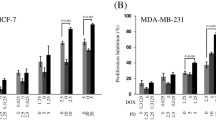Abstract
Doxorubicin (Dox) is widely used to treat a variety of tumors. However, resistance to this drug is common, making successful treatment more difficult. Previously, we introduced a novel phytosphingosine derivative, N,N-dimethyl phytosphingosine (DMPS), as a potent anticancer therapeutic agent in human leukemia cells. This study was performed to investigate whether DMPS can sensitize HL-60/MX2, a multidrug-resistant variant of HL-60, to Dox-induced apoptosis. Low concentrations of DMPS sensitized HL-60/MX2 cells to Dox-induced apoptosis. Combined Dox + DMPS treatment-induced apoptosis was accompanied by the activation of caspase-8 and caspase-3 as well as PARP cleavage. Cytochrome c and AIF release were also observed in Dox + DMPS-treated HL60/MX2 cells. Pretreatment with z-VAD-fmk markedly prevented caspase-3 activation and moderately suppressed apoptosis, suggesting that Dox + DMPS-induced apoptosis is somewhat (not completely) dependent on caspase. Cytochrome c and AIF release were not affected by pretreatment with z-VAD-fmk. The ROS scavenger NAC efficiently suppressed not only ROS generation, but also caspase-3-mediated PARP cleavage, apoptosis, and release of cytochrome c and AIF, indicating a role of ROS in combined Dox + DMPS treatment-induced apoptotic death signaling. Taken together, these observations suggest that DMPS may be used as a therapeutic agent for overcoming drug-resistance in cancer cells by enhancing drug-induced apoptosis.






Similar content being viewed by others
Abbreviations
- AIF:
-
Apoptosis-inducing factor
- DMPS:
-
N,N-Dimethyl phytosphingosine
- Dox:
-
Doxorubicin
- FACS:
-
Fluorescence-activated cell sorting
- IAP:
-
Inhibitor of apoptosis proteins
- MDR:
-
Multidrug resistance
- MMP:
-
Mitochondrial membrane potential
- NAC:
-
N-Acetylcysteine
- pNA:
-
p-Nitroanilide
- ROS:
-
Reactive oxygen species
- S1P:
-
Sphingosine-1-phosphate
- SK:
-
Sphingosine kinase
- Tiron:
-
4,5-Dihydroxy-1,3-benzenedisulfonic acid
- z-VAD-fmk:
-
N-Benzyloxycarbonyl-Val-Ala-Asp-fmk
References
Nakamura T, Ueda Y, Juan Y, Katsuda S, Takahashi H, Koh E (2000) Fas-mediated apoptosis in adriamycin-induced cardiomyopathy in rats: in vivo study. Circulation 102:572–578
Navarro R, Martínez R, Busnadiego I, Ruiz-Larrea MB, Ruiz-Sanz JI (2006) Doxorubicin-induced MAPK activation in hepatocyte cultures is independent of oxidant damage. Ann NY Acad Sci 1090:408–418
Harker WG, Slade DL, Dalton WS, Meltzer PS, Trent JM (1989) Multidrug resistance in mitoxantrone-selected HL-60 leukemia cells in the absence of P-glycoprotein overexpression. Cancer Res 49:4542–4549
Kim BM, Choi YJ, Han Y, Yun YS, Hong SH (2009) N, N-dimethyl phytosphingosine induces caspase-8-dependent cytochrome c release and apoptosis through ROS generation in human leukemia cells. Toxicol Appl Pharmacol 239:87–97
Spiegel S, Milstien S (2002) Sphingosine 1-phosphate, a key cell signaling molecule. J Biol Chem 277:25851–25854
Choi SY, Kim MJ, Chung HY, Lee SJ, Jang YJ (2007) Phytosphingosine in combination with TRAIL sensitizes cancer cells to TRAIL through synergistic up-regulation of DR4 and DR5. Oncol Rep 17:175–184
Park MT, Kang YH, Park IC, Kim CH, Lee YS, Chung HY et al (2007) Combination treatment with arsenic trioxide and phytosphingosine enhances apoptotic cell death in arsenic trioxide-resistant cancer cells. Mol Cancer Ther 6:82–92
Scaffidi C, Fulda S, Srinivasan A, Friesen C, Li F, Tomaselli KJ et al (1998) Two CD95 (APO-1/Fas) signaling pathways. EMBO J 17:1675–1687
Luo X, Budihardjo I, Zou H, Slaughter C, Wang X (1998) Bid, a Bcl2 interacting protein, mediates cytochrome c release from mitochondria in response to activation of cell surface death receptors. Cell 94:481–490
Li H, Zhu H, Xu CJ, Yuan J (1998) Cleavage of BID by caspase 8 mediates the mitochondrial damage in the Fas pathway of apoptosis. Cell 94:491–501
Chandra D, Choy G, Deng X, Bhatia B, Daniel P, Tang DG (2004) Association of active caspase 8 with the mitochondrial membrane during apoptosis: potential roles in cleaving BAP31 and caspase 3 and mediating mitochondrion-endoplasmic reticulum cross talk in etoposide-induced cell death. Mol Cell Biol 24:6592–6607
Chakraborti T, Das S, Mondal M, Roychoudhury S, Chakraborti S (1999) Oxidant, mitochondria and calcium: an overview. Cell Signal 11:77–85
Gottlieb E, Vander Heiden MG, Thompson CB (2000) Bcl-x(L) prevents the initial decrease in mitochondrial membrane potential and subsequent reactive oxygen species production during tumor necrosis factor alpha-induced apoptosis. Mol Cell Biol 20:5680–5689
Skulachev VP (2006) Bioenergetic aspects of apoptosis, necrosis and mitoptosis. Apoptosis 11:473–485
Tang D, Lahti JM, Grenet J, Kidd VJ (1999) Cycloheximide-induced T-cell death is mediated by a Fas-associated death domain-dependent mechanism. J Biol Chem 274:7245–7252
Juin P, Hueber AO, Littlewood T, Evan G (1999) c-Myc-induced sensitization to apoptosis is mediated through cytochrome c release. Genes Dev 13:1367–1381
Yin XM (2000) Signal transduction mediated by Bid, a pro-death Bcl-2 family proteins, connects the death receptor and mitochondria apoptosis pathway. Cell Res 10:161–167
Martinou JC, Desagher S, Antonsson B (2000) Cytochrome c release from mitochondria: all or nothing. Nat Cell Biol 2:E41–E43
Dinsdale D, Zhuang J, Cohen GM (1999) Redistribution of cytochrome c precedes the caspase-dependent formation of ultracondensed mitochondria, with a reduced inner membrane potential, in apoptotic monocytes. Am J Pathol 155:607–618
Wigdal SS, Kirkland RA, Franklin JL, Haak-Frendscho M (2002) Cytochrome c release precedes mitochondrial membrane potential loss in cerebellar granule neuron apoptosis: lack of mitochondrial swelling. J Neurochem 82:1029–1038
Daugas E, Nochy D, Ravagnan L, Loeffler M, Susin SA, Zamzami N et al (2000) Apoptosis-inducing factor (AIF): a ubiquitous mitochondrial oxidoreductase involved in apoptosis. FEBS Lett 476:118–123
Granville DJ, Cassidy BA, Ruehlmann DO, Choy JC, Brenner C, Kroemer G et al (2001) Mitochondrial release of apoptosis-inducing factor and cytochrome c during smooth muscle cell apoptosis. Am J Pathol 159:305–311
Candé C, Cecconi F, Dessen P, Kroemer G (2002) Apoptosis-inducing factor (AIF): key to the conserved caspase-independent pathways of cell death? J Cell Sci 115:4727–4734
Acknowledgments
This work was supported by the National Nuclear R&D Program of the Ministry of Education, Science and Technology (MEST) of the Republic of Korea.
Author information
Authors and Affiliations
Corresponding author
Rights and permissions
About this article
Cite this article
Kim, B.M., Choi, Y.J., Lee, Y.H. et al. N,N-Dimethyl phytosphingosine sensitizes HL-60/MX2, a multidrug-resistant variant of HL-60 cells, to doxorubicin-induced cytotoxicity through ROS-mediated release of cytochrome c and AIF. Apoptosis 15, 982–993 (2010). https://doi.org/10.1007/s10495-010-0512-x
Published:
Issue Date:
DOI: https://doi.org/10.1007/s10495-010-0512-x




